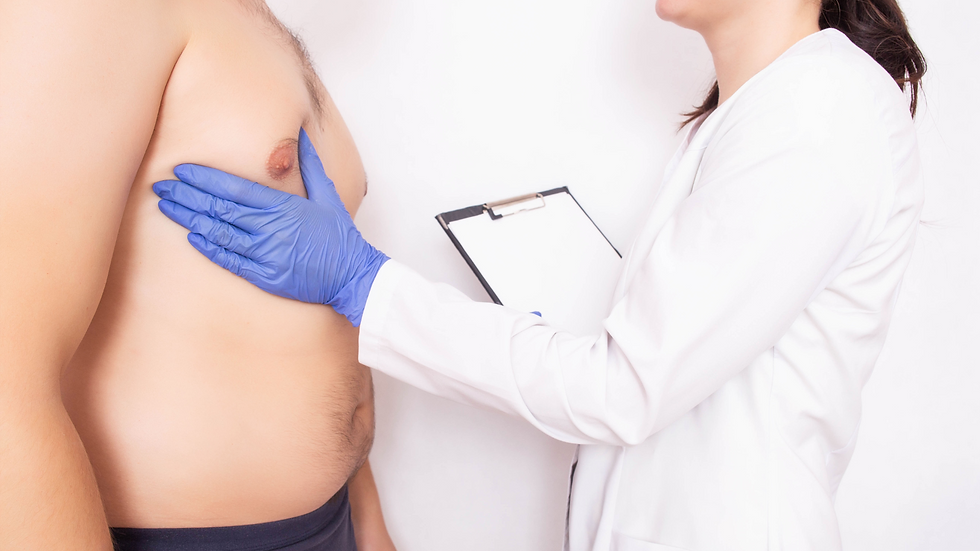Symptoms of breast cancer in men
- MedSIR

- Oct 17, 2022
- 3 min read

Breast cancer in men is a very rare pathology, however there are studies that say that its incidence is increasing. Although it is unknown exactly why, it seems that little by little men are communicating more to their doctors the symptoms that appear in their breasts and for this reason we are diagnosing them with increasing frequency.
The visibility of male breast cancer is increasing, as we give it normality, and reduce the stigma and belief that breast cancer only happens in women. Even so, there are still studies that say that the time from the appearance of the first symptoms to the diagnosis is around a year and a half. The delay in diagnosis is the reason that most male breast cancer patients have more advanced stages of breast cancer.
We’ll focus today on signs and symptoms of breast cancer in men, which will help them determine if they should consult their primary care doctors so that they can carry out a correct physical examination and an imaging test in appropriate cases.
What are the early symptoms of breast cancer in men?
1. Lump in a breast
It is the most frequent symptom, present in 90% of cases of breast cancer in men.
When a "lump" appears in one breast, the first thing we have to do is find out if it is unilateral or bilateral, that is, rule out that there is another in the other breast. In the case of bilaterality, it is most likely benign.
The increase in size of both breasts in men is known in medicine with the term gynecomastia. It is neither malignant nor a precursor to malignancy. The causes are multiple: obesity, taking certain drugs, alcohol abuse, etc. Gynecomastia can be diffuse (affecting the entire breast) or nodular. In the latter case, it can be confused with a tumor, either benign (such as lipomas) or malignant (such as infiltrating ductal carcinoma)
2. Nipple discharge
The technical term telorrhea, describes fluid that comes out of the nipple. Although it is always convenient to analyze this liquid by means of a cytology study, there are data that support that it is of benign origin, such as bilaterality, discharge from more than one nipple orifice, and the appearance of the discharge.
When the liquid is purulent, it is more likely to be an inflammatory or infectious process, while if it is bloody (telorrhagia), it is more likely to be a tumor. The presentation of telorrhagia as a single symptom in men is very rare, but if it does appear, its association with malignancy is much more frequent than in women.
The negativity of the cytological analysis does not rule out malignancy. It is necessary to perform an imaging test (mammography and/or ultrasound) to analyze an underlying lesion and perform a biopsy.
3. Skin and/or nipple changes
Nipple retraction in male breast cancer is much more common than in women because its most common location is retro areolar. If it appears in any other location of the breast, it can also retract the overlying skin. In the same way, it is also necessary to study the ulcerations of both the skin and the nipple.
4. Axillary adenopathy
Along with the appearance of the nodule in the breast, it is the most frequent symptom of presentation of breast cancer in men. As we have mentioned, the diagnostic delay usually means that the tumor cells have already left the primary tumor, the breast in this case, to begin their growth in the lymph nodes. This is the fundamental cause of a worse prognosis.
When an enlarged lymph node appears in the armpit, other much more frequent causes must be ruled out, such as infections or tumors in other organs, but we must not forget the breast examination.
Have confidence with your doctor, consult if you have doubts, do not be ashamed, there are no "things for women or men", there are signs and symptoms, problems, illnesses and concerns. The vast majority are benign and with treatment, but when they are malignant, the sooner it is known, the better.
Though rare, male breast cancer still occurs, if you have concerns or questions please contact us, we're always here to help!
Article written by:

Anna Lopez, Doctor in medicine. Medical Oncologist at the León University Assistance Complex , Breast Unit. Resident Tutor. Head of the Clinical Trials Unit.






Comments